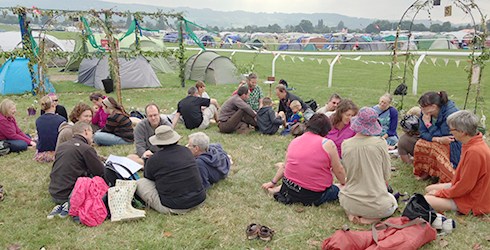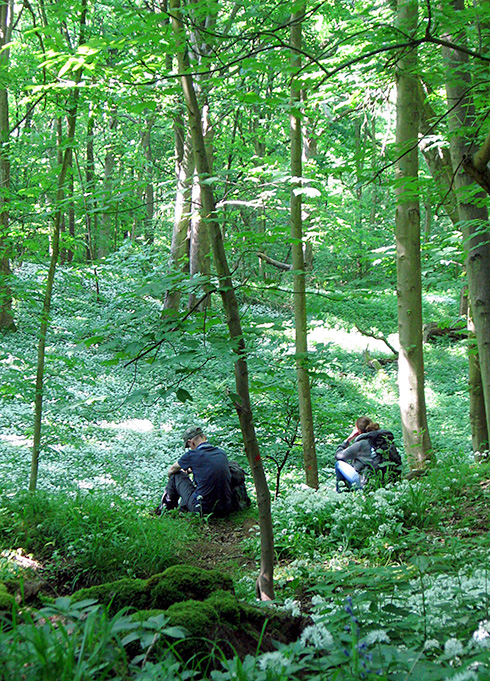Talking to Trees
Of all the experiential nature connection ideas I’ve been exploring and advocating through workshops and the Forest Church book, the one that has raised more questions than anything else is the idea of conversing with nature.
And yes, I am actually talking about an actual conversation where you say words and listen for the reply, not just with trees but with whatever in nature initiates a conversation with you from an ant to a landscape. Mad? Animistic? Anthropocentric? Impossible? What do you think?

This past Greenbelt 2013, I ran a workshop (above) called Worshiping With The Trees as part of the programme of events at The Grove. I’d originally planned to take the group of participants to various trees and give them interesting bits of science and folklore – but instead I thought it would be more useful to share or test out some more direct, practical, ideas I’ve been working on (partly inspired by Goethean philosophy).
The difficulty with the ‘conversing with nature’ intervention is that if you deconstruct it too much to begin with you risk disempowering it altogether. If participants can only interpret that you’re suggesting that the tree has an intelligence that you supernaturally converse with – or at the other end of the spectrum, you’re instructing them to talk, mechanically, to an inanimate object – then we’re a bit stuck; it is actually an exercise or intervention that needs a careful introduction and some maturity (and playfulness) on the part of the participant. It is a core element of a lot of vision quest work. (One book that explores the concept in greater details is Soulcraft by Bill Plotkin – a good book, although he does come from the perspective that we’re all wounded and need healing, which I totally disagree with, but that’s another story.)
During the Greenbelt workshop, we explored, not in any great depth, a progressive model for connecting with nature where the possibility of a conversation was only one element.
The aim of the model is to participate with nature which begins with connection and this method visits the same tree (for example) three different ways: firstly through the senses, secondly through the imagination and lastly through spirit. For anyone familiar with the Study, Meaning and Awe model in the Forest Church book, there is considerable overlap – and some prefer one to the other. The following include some of the ideas generated by the Greenbelt group.

Connect through the senses.
At this stage you are meeting the tree (for example) only through your senses. This is the first connection. There is something quite strict and scientific about this attempt to see (for example) as if for the first time. Put to one side anything you already know such as names, labels and ideas. In fact, if making the observation with someone else or as a journal entry, attempt to use new language to describe the object; reduce nomenclature. Drawing is another obvious technique. Do this for as long a time as you are able and give the same time to the second and third ways to connect.
Some of the ideas I really liked from the Greenbelt workshop included the idea of blindfolding yourself to deprive your dominant sense. Likewise make sure you touch, smell and, if you know what you’re doing, taste. When you use your eyes change your perspective, lie down, stand on your head, look at a reflection of the object in a mirror. I really liked the suggestions to make the connection in all weathers, and likewise connect at different times of the day. Connect through touch not just with your hands; walk barefoot for example.
Connecting through imagination.
At this stage you use your imagination, interrogative thinking and creativity to move beyond simply what is. One example is to imagine the thing (tree, leaf, stone, river valley etc) through time, imagining its process of development, this time imagining the sights, smells, touch etc. This relates closely to observing the interactions between different aspects of the landscape – a core element of landscape reading. You are moving from what is seen to imagining what might be. You’ve observed the tree’s current, static, objective state and now you use your imagination to think through its relationship, communication and interactions with its surroundings over time.
A transition occurs during this stage, as your attempt to perceive and imagine the object stops, and the object itself begins to express itself in its own way. This is where a conversation may occur. Or it may not. It is here, also, that as Goethe describes it, “new organs of perception” come to the fore; other senses. What might be said by the object might contradict what you may otherwise have thought; it might surprise you. The aim is to experience and feel (discern, intuit) something of the being of the thing.
At Greenbelt we weren’t able to cover the detail of this but nevertheless some interesting contributions were made. One suggested singing the landscape – on which could be built the idea that movement, dancing and other ways of expression such as art and sculpture might play a part in this connection through imagination.
Connecting spiritually.
There is a natural continuation from the previous stage that works best when the observer can de-centralise themselves from the exercise (it’s not all about you) and move beyond the separateness we think we have with nature. Participate. Be receptive and attentive. What is perceived of the anima loci of the place, its soul, or its genius loci, its spirit? You might find other language, such as ‘energy’ more or less helpful.
Can we perceive something of the existing conversation or connection between nature and God? Can we tune into it? The heavens are declaring the glory of God, day after day they pour fourth speech. The mountains and the hills burst into song. The trees clap their hands. God speaks to the heavens and the earth; winds become God’s messengers, fire God’s minister. God’s very Spirit is present in all things.
My own sense, for what it’s worth, is that some different natural phenomenon, things and places, do have a distinct spiritual feel about them but in most cases I believe I am sensing the Holy Spirit’s many faceted presence, like the different colours of light coming from a single crystal. And without being superstitious, it may be that other (possibly negative) spirits are discernable too (which is another, another story).
“Don’t be afraid” someone has written down from the Greenbelt workshop. Good advice. As is to be childlike. Turn off the noise. Consider the wisdom of other traditions. Be part of what is there.
One more quote from scripture would remind us that creation is not just celebrating God but also groaning as if in labour – when you connect spiritually it can be a delightful, enhancing experience but if that is all it is, I’d be disappointed. Hopefully the connection might encourage each of us in our role as priests to all creation – what does that mean to you?
Please bookmark this post at Facebook or Twitter:


Your comments:

Pleasley Forest Church
Encountering the Eternal One within the ancient boundaries of Sherwood Forest More ...

Essex Forest Church
We seek to find the presence of God in the open air and in nature, and to connect with the Divine Being who is present in creation. We seek to foster a love of creation, a love which will lead us to care for it. We look for reconciliation between nature and human beings, and within human relationships. More ...
oxforddiocese:
Great to see how @RiponCuddesdon are engaging with @ARochaUK Eco Church scheme - love the Forest Church area made b… twitter.com/i/web/status/1…
18 Aug 22
YBS_Church:
Our Forest Church takes place on Sunday, 28th August, at 4.30pm in the Gifford Community Woodland (Fawn Wood), for… twitter.com/i/web/status/1…
19 Aug 22
rebeccaBug:
Tremeirchion have their first Forest Church service tomorrow so the boys thought they had better check out that the… twitter.com/i/web/status/1…
20 Aug 22

Glad to read that people are interested in “talking to trees”. I’ve found over the years the best way for me is to walk in the woods for a while then sit under a tree with your back touching it and just listen. Hear, sense & feel it’s movement. The colours, texture and temperature. Sometimes restful, sometimes not; just go with the flow allow your inner being to connect.
#1. By Ali on September 18, 2013